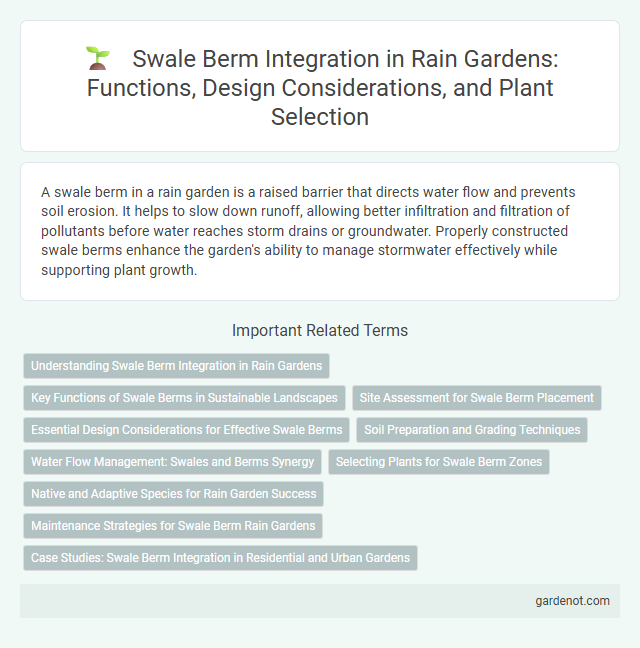A swale berm in a rain garden is a raised barrier that directs water flow and prevents soil erosion. It helps to slow down runoff, allowing better infiltration and filtration of pollutants before water reaches storm drains or groundwater. Properly constructed swale berms enhance the garden's ability to manage stormwater effectively while supporting plant growth.
Understanding Swale Berm Integration in Rain Gardens
Swale berms are engineered mounds designed to optimize stormwater flow within rain gardens, enhancing infiltration and preventing erosion. Proper integration involves contouring these berms to direct runoff toward planting areas, maximizing water retention and supporting vegetation growth. Effective swale berm design ensures sustainable water management by slowing runoff and promoting groundwater recharge.
Key Functions of Swale Berms in Sustainable Landscapes
Swale berms serve as critical components in sustainable landscapes by directing stormwater runoff, promoting infiltration, and reducing soil erosion. These earth mounds temporarily detain water, allowing pollutants to settle and enhancing groundwater recharge, which supports plant health and biodiversity. Properly designed swale berms also minimize flooding risks while improving water quality in urban and suburban environments.
Site Assessment for Swale Berm Placement
Site assessment for swale berm placement in rain gardens involves analyzing topography, soil permeability, and drainage patterns to identify optimal locations that maximize water capture and infiltration. Evaluating slope gradients and existing runoff flow paths ensures the berm effectively slows and directs stormwater, reducing erosion and promoting groundwater recharge. Soil testing for texture and compaction aids in determining areas suitable for swale berm stability and long-term performance.
Essential Design Considerations for Effective Swale Berms
Swale berms must be strategically designed to capture and slow runoff, utilizing appropriate soil composition with high permeability to enhance water infiltration and prevent erosion. Elevation and slope gradients should be precisely calculated, typically maintaining a gentle incline between 2% and 5%, to ensure controlled water flow without causing overflow or saturation. Vegetation selection is critical, favoring deep-rooted native plants that stabilize soil, filter pollutants, and increase water absorption for a sustainable rain garden ecosystem.
Soil Preparation and Grading Techniques
Swale berm soil preparation involves loosening compacted soil to enhance infiltration and nutrient absorption, often incorporating organic matter to improve soil structure. Precise grading techniques ensure swale berms have a gentle slope, typically between 1-5%, directing runoff efficiently while preventing erosion. Properly graded soil profiles create optimal conditions for rain garden vegetation and maximize stormwater management performance.
Water Flow Management: Swales and Berms Synergy
Swale berms play a crucial role in rain garden water flow management by directing and slowing runoff to maximize infiltration and reduce erosion. Their synergy enhances stormwater control by channeling water through vegetated swales, promoting groundwater recharge and filtering pollutants. Strategic placement of swale berms optimizes rain garden performance in managing surface water efficiently.
Selecting Plants for Swale Berm Zones
Selecting plants for swale berm zones requires focusing on species adapted to varying moisture levels and soil types, ensuring effective water filtration and erosion control. Native grasses, sedges, and moisture-tolerant perennials such as Carex, Juncus, and Asclepias provide deep root systems that stabilize soil and enhance pollutant uptake. Plant diversity in swale berms supports habitat benefits while maintaining structural integrity through seasonal fluctuations in water flow.
Native and Adaptive Species for Rain Garden Success
Swale berms in rain gardens thrive when planted with native and adaptive species, enhancing water filtration and soil stabilization. These plants, such as switchgrass (Panicum virgatum) and blue flag iris (Iris versicolor), are well-suited to fluctuating moisture conditions typical of swale berms. Incorporating deep-rooted native plants improves runoff absorption and supports local biodiversity, ensuring long-term ecological success.
Maintenance Strategies for Swale Berm Rain Gardens
Effective maintenance strategies for swale berm rain gardens include regular inspection and removal of sediment and debris to ensure unobstructed water flow. Periodic trimming of vegetation prevents overgrowth while promoting healthy plant establishment and soil stabilization. Implementing erosion control measures, such as adding mulch or reinforcing berm edges, helps maintain structural integrity throughout varying weather conditions.
Case Studies: Swale Berm Integration in Residential and Urban Gardens
Swale berms have been successfully integrated into residential and urban rain gardens, demonstrating effective stormwater management and enhanced local biodiversity. Case studies reveal that these earth berms direct runoff into planted areas, reducing erosion and promoting groundwater recharge in compact urban settings. Incorporating swale berms in urban landscapes contributes to improved water quality and increased resilience against flooding.
Swale berm Infographic

 gardenot.com
gardenot.com